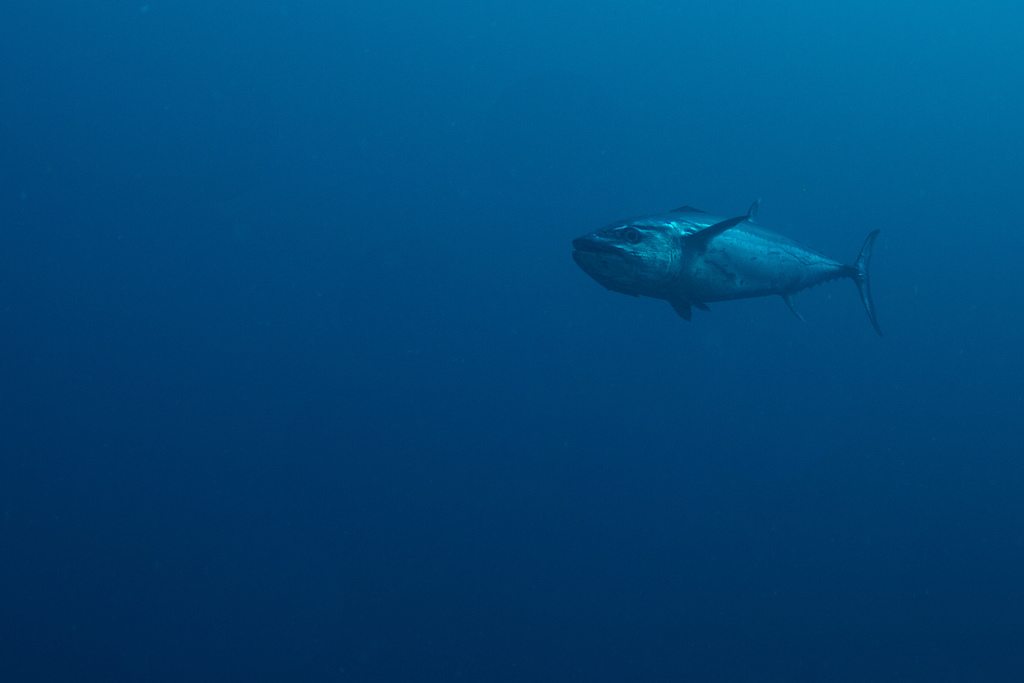Canned tuna’s rise from obscure protein to home kitchen ubiquity—and subsequent fall into two-fer grocery aisle oblivion—reads a little like an F. Scott Fitzgerald novella (if F. Scott had written primarily about fish). It’s been a long strange trip for the stuff. By 1989, when my mother and the mothers of all my friends were subsisting mostly on a diet of canned tuna, tomato, and iceberg lettuce, America’s affection for the tinned fish had reached unparalleled proportions.
In 2014, Roberto A. Ferdman wrote a compelling history of canned tuna for the Washington Post, in which he noted that the average American eats almost four pounds of the fish each year. “In 1990,” he wrote, “the International Trade commission estimated that Americans were responsible for eating about a third of the global supply of tuna, and between half and two-thirds of the global supply of canned tuna.”
But then came mercury levels. And dolphin bycatch. And canned-food aversion. And so it was that our ever growing sustainability and food quality concerns began to outpace our desire for high-protein, low-cost “Breast-O’-Chicken” of the sea.
By 2015, the Food and Agriculture Organization of the United States (FAO) was reporting that U.S. imports of processed tuna were down 14 percent from the previous year. That followed a sharp downturn in 2013, when sales reached their lowest point in 15 years.
And it was under those troubled market conditions that the “Big 3” tuna suppliers (Bumble Bee Foods, StarKist, and Tri-Union Seafoods)—and possibly others—conspired to fix the prices of packaged tuna products. At least that’s big retailers like Walmart, Wegmans, and Kroger allege in a class-action they filed back in October of 2016.
As we reported last week, Bumble Bee pleaded guilty to a one-count felony charge and agreed to pay a $25 million criminal fine for its role in the price-fixing conspiracy. But that settlement was the result of a concurrent Department of Justice (DOJ) Antitrust Division investigation. The retailer class-action continues.
Late last week, new details emerged, getting much more specific about just how the “Big 3” may have conspired to fleece canned fish fans. Industry publication Intrafish reported on Thursday of this week that Walmart and other supermarket chains had filed new complaints in the class-action, alleging that top executives at the “Big 3” had decided together to reduce the size of their cans from six to five ounces, while collectively raising prices at the same time.
What’s new here is that the plaintiffs also allege the conspiracy dates back much further than originally thought—possibly as many as seven years before. The DOJ investigation said the companies had been colluding from as early as the first quarter of 2011 until at least the fourth quarter of 2013. But the amended class-action complaint says the scheme to abandon competition may actually have been conceived in 2004, and officially gone into action three years later.
The new complaint alleges that, in 2007, an executive at one of the companies made the decision to reach out to fellow suppliers about converting its cans. Throughout the following year, says the complaint, all three companies laid the groundwork, settled on a price, and closed the deal.
An analysis published Thursday on industry site Seafood News points out a few other interesting facets of the civil suit. “Under US law, companies in similar industries are encouraged to form voluntary trade associations to collectively address issues of concern such as food safety, federal regulation, lobbying, and market development,” writes editor John Sackton. “These are all areas where collective industry action is more effective than single efforts by individual companies. There is no violation of anti-trust if executives who are competitors are meeting together on these issues.”
In other words: the plaintiffs will have to make the case that, because meetings were held between executives while doing legitimate business, they violated their obligation not to discuss pricing. If they are successful in doing so, the retailers may be awarded significant damages—that is, if they can prove exactly how they were damaged by the conspiracy.










